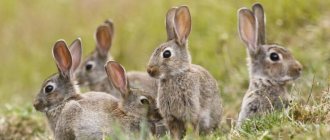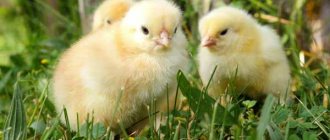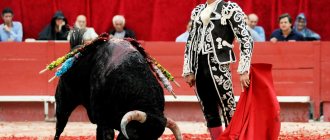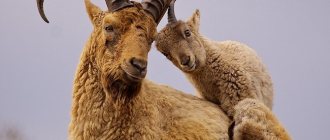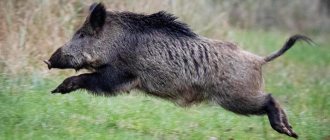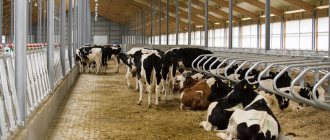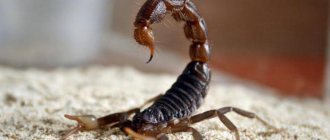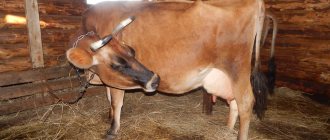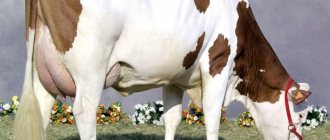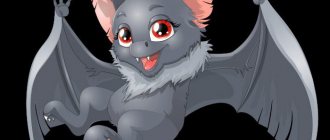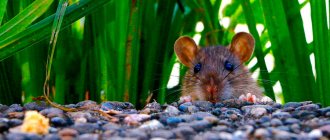The last place on the planet where the animal walked is the European continent; the last specimen of this animal was a female who died in 1627 in the forests of Poland.
Due to the spread across continents, there were three subspecies of this bull :
- European;
- African;
- Indian.
Each subspecies contributed to the gene pool of modern domestic cattle. Thus, the African aurochs is the ancestor of modern African breeds, for example, the Watussi bull. The Indian subspecies is the ancestor of modern European breeds.
Taxonomy
Very often, aurochs are considered European bison , however, these are different animals.
The first examples of this misunderstanding appeared in the second half of the 18th century, when the first naturalists from Europe began to draw up the first biological classifications. At that time, the live aurochs had not existed for 100 years, and the number of bison was rapidly decreasing. There was no reliable information about the aurochs or the bison in Western Europe, so Karl Lennay decided to leave this question open. Two opposing movements of naturalists immediately arose .
Supporters of the first defended the thesis of the existence of a single wild species of cattle, considering both the bison and the aurochs to be representatives of the same species. In contrast, there was another opinion, whose adherents believed that domestic cows and wild bison were different animals, and therefore two different species must have existed in ancient Europe. We also recommend reading:
The largest bulls with officially recorded parameters Cows are capable of being friends Genetics have bred hornless dairy bulls Serenade for a cow
In the early 19th century, the excavation of dozens of skeletons scattered throughout Europe resolved the controversy. Studies of these skeletons confirmed that the aurochs are very similar in characteristics to domestic cows and different from bison. Subsequently, African and Indian subspecies began to be distinguished within the bull species itself. The name "Aur" comes from the language of the ancient Gauls and means "wild mountain bull", a description of which is found in many Roman literary sources of the time. This animal is also called a wild bull in the Bible.
On the slopes of the Caucasus
They also have their authorized representatives on the territory of the Russian Federation. The Caucasian tour is widely known. This animal lives in a remote part of the region, mainly in the area of the Russian-Georgian border, and has two varieties: Western Caucasian and Eastern Caucasian. Sometimes it is called Caucasian. In recent years, alarming trends have emerged in the existence of these species. Their population has noticeably decreased, and this fact requires the adoption of vigorous legal measures aimed at preventing poaching. However, due to the complexity of the situation in many regions of the Caucasus, it is not so easy to implement environmental protection measures in practice. It is not enough to list an endangered animal in the International Red Book; it is also necessary to ensure a real regime for its protection.
In the black book of animals you can find many species that humans have destroyed through hunting, deforestation and pollution of the ecosystem. Each of these stories is unique and represents a horrific crime, but some of them are reminders of the confrontation between nature and humanity, as was the case with the primeval bull known as the aurochs.
This animal, which finally became extinct in 1627, is known as the ancestor of modern cattle.
Turs were destroyed for meat and fun until these proud and strong animals were on the verge of complete extinction, but even then, taking into account the laws on the protection of bulls, it was not possible to save the species.
Short story
The first representatives of the aurochs originate from central Asia approximately 2 million years ago.
From here they gradually spread towards all parts of the world, reaching the territories of India, Russia, China, the Middle East, Africa and Europe. Approximately 700-800 thousand years ago, the wild bull aurochs appears on the territory of the Iberian Peninsula and inhabits northern Europe, reaching Germany approximately 250,000 years ago. Climatic changes on the planet ensured the subsequent existence of three subspecies of the animal, which were mentioned earlier in the article.
Human pressure on the wild aurochs has increased over time , from hunting for its meat (for which reason the animal disappeared from Great Britain around 1300 BC) to deforestation for agricultural purposes and competition for pastures with domesticated cows . Before the era of the Roman Empire, this species of mammals had already disappeared from the territories of northern Africa, the coasts of the Mediterranean Sea, Mesopotamia and India.
In the Middle Ages, only the European aurochs remained in the territory of eastern Germany, and in the 16th century the animals remained only in the territories of the Polish forests of Jaktor and Wiskitka. In 1476, these forests, along with the right to hunt in them, became the property of the royal family, and only the king had the privilege of killing a bull. During the reign of Sigismund the First the Elder and his heir, animals were treated very carefully, they made sure that people and other animals did not bother them, and in winter they fed the aurochs with hay. Subsequent kings were not so caring towards the ancestor of cows and continued to actively hunt them.
Several censuses of the number of Polish aurochs reflect its slow decline, so in 1564 there were 38 specimens, in 1566 only 24 individuals remained, in 1602 only 5 individuals were found, 4 males were killed while hunting in the next 20 years, the last female died of natural causes in 1627 year.
Habitat
Initially, the habitat of the tours was considered to be:
- Europe;
- Asia, including Mongolia, China, Turkey and India.
Large herds roamed the steppe. Due to the activity of hunters, they began to move to the forest-steppe. They fell in love with areas with wet and marshy soils. The remains of the last representatives of the species were most often found in Poland.
The development of farming led to a gradual reduction in the area of their residence. As a result, the herds were deprived of their source of food, which was especially obvious in winter. This led to the forced migration of animals, which may have caused the development of diseases that led to complete extinction.
Description of the animal's appearance
The European aurochs was a robust animal, with a hunched back as a result of long vertebrae. The animal's head was large and longer than that of modern domestic cows. Below is a reconstructed image of an extinct wild ox as it looked like.
He had huge and strong horns, white at the base and black at the ends of the horns. The length of the horns could reach 1 m, with a shape in the form of an ancient lyre. The animal had long limbs, so it could develop impressive speed. The average height of the animal to the rump ranged from 160 to 180 cm, in the case of males it could reach 2 m. Based on the description of the animals in Roman and medieval sources, it can be concluded that they had dark fur.
Animal behavior
These animals were aggressive , capable of attacking anyone who did not maintain sufficient distance, very strong and fast, which could even attack a person.
Animals united in herds consisting of males, females and their young. Herd size varied. Old males usually left the herd and led a solitary life. According to Polish chronicles of the 16th and 17th centuries, the country in which the last representatives of this species lived, mating of animals took place in August and September. In May and June, offspring were born. The animal's habitat is dense forests and plains . Moreover, in areas with more vegetation and water, the number of livestock was higher than in other areas. The aurochs is a herbivore, so it ate various types of leaves, grass and soft branches. The animals most likely migrated according to the seasons, moving at intervals similar to how African antelopes do today. The natural enemies of the aurochs were the following animals:
- lions (before their extinction in Europe);
- wolves;
- the Bears.
Reproduction of primitive bulls
Mating among aurochs occurred in September. Fierce fights took place between the males at this time, often ending in the death of both sides.
Calving occurred in May. Before calving, the females retired into the thicket, where they remained with the newborns for about 20 days. After that we went out to more open places. Mothers carefully protected their calves from wolves and humans. Occasionally, cases of late mating and calving were observed (in September), but, as a rule, calves born in the fall died in the winter.
There were numerous cases of wild aurochs mating with livestock, but the hybrid offspring turned out to be nonviable and for some reason died, especially in harsh winters.
Domestication of the aurochs
Analysis of the genes of various species of modern cows confirmed that the domestication of the aurochs occurred in different places and by different peoples. The first mentions of the domestication of wild bulls are found in Greece and are about 8,500 years old. A little later, the tour was domesticated in India, Asyria, from where it was transported to Mesopotamia, Anatolia, Canaan and Egypt. Around the first millennium BC, there are references to the domestication of tur on the territory of the Iberian Peninsula, brought there through the Strait of Gibraltar.
Photo gallery
We invite you to see what the bull auroch looked like in the photos provided below.
Graphic representation of the tour
Skeleton tour in the museum
Person to tour size ratio
Monument to the Tour in Estonia
Attempts to recreate the species
In the 1920s, the German brothers Lutz and Heinz Heck proposed to “recreate” the extinct aurochs species by crossing different types of cows, while selecting for typical aurochs characteristics in each generation.
The result was the appearance of the species "Heck's tur" or the more common name "Hake's bull". The resulting breed had a large body size, was strong, had long horns and black or brown hair. However, critics attacked the new breed already when the first “Heck bull” was born. The fact is that many of the characteristics of the bred breed did not correspond to reality and were the result of breeder mistakes. At the same time, the resulting “Heck Tur” had even less similarities with the ancient wild bull than other domestic breeds of cows. In various places on the planet, natural selection led to the emergence of breeds of cattle, which in their characteristics were closer to the aurochs than the “Heck bull”.
Indeed, Van Voor even showed that modern Indian bulls are closer ancestors of the wild aurochs than the Heck bull. The experiment to recreate the race of the ancient aurochs failed, although at present this unsuccessful artificially bred species of bull is included in the natural reserve of the Netherlands and Germany.
Moreover, these supposed modern aurochs continue to represent animals that do not resemble the ancient aurochs in size, horn length, or coat color. If we consider the aspect of temperament, then the situation here is even worse, since the bred species is unable to obtain enough food in the winter and is unable to independently defend itself from wolves. For these and other reasons, critics consider the experiment a failure and sneer that Heck's aurochs are simply domestic cows that have been taken out of their stalls and forced to live in the forest. Professor Z. Pusek, responsible for the program for restoring the European bison in the forests of Poland, called the Heck bull “the biggest scientific hoax of the 20th century.”
Currently, attempts to recreate the ancient tour continue , for example, it should be said about the TaurOs project, which is based on the exact genetic and morphological characteristics of ancient animals. In this project, greater preference is given to breeds that have primitive characteristics, such as the highland Scottish bull, the Hungarian steppe bull, the dwarf Turkish bull and others.
Revival of a legend
It would be strange to wonder why the historical species has not yet been restored if modern genetics has simply fantastic abilities. This kind of work has been done before and is being done now. Several interesting developments can be noted:
- During Nazi Germany, German geneticists carried out colossal work to revive the wild aurochs. Geneticists understood the reason why the species began to die out and restored the necessary genetic links. However, the result was a completely new species, which looked more like a modern specimen than a historical one. In addition, after the defeat of Hitler, the entire species was destroyed and irretrievably lost.
- The environmental company Taurus Foundation, based in Holland, has also committed to reviving the historic site. The work is still ongoing, but the company talks about significant progress in this area.
- The Polish organization for reproducing the tur has been actively working to rehabilitate the genetics of the ancient animal for several decades. The main goal of the company is to create an individual by cloning, based on the genetic base that was collected during the excavation of tur bones.
It is now becoming very important to know what the ancient species might have looked like. For example, the current cow, although a “relative” of the aurochs, is similar to it solely in body structure. In addition, the cow will not be able to lead a wild lifestyle. Research must resolve such an important issue as the smooth combination of appearance and character of the species.
No matter how modern research proceeds, in any case the result will not be a historical tour, but its external copy. It is probably quite possible to create the appearance of an animal, but its character will be more “domestic” than the aggressive one that clearly characterized a wild animal . And yet, everything must be done to ensure that the rarest historical species that are still preserved on earth do not disappear irrevocably, as happened with the legendary tour.
